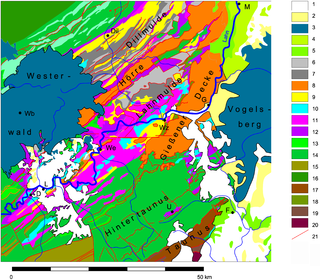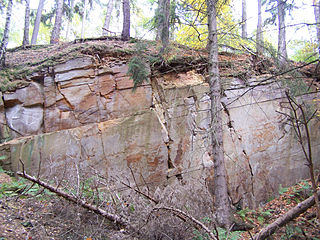Friedrich von Huene, full name Friedrich Richard von Hoinigen was a German paleontologist who renamed more dinosaurs in the early 20th century than anyone else in Europe. He also made key contributions about various Permo-Carboniferous limbed vertebrates.
Sclerorhynchus is an extinct genus of ganopristid sclerorhynchoid that lived during the Late Cretaceous. The genus Ganopristis is considered a junior synonym of Sclerorhynchus. It was a widespread genus, with fossils found in the Middle East, North Africa, Europe, and North America. While it had a long rostrum with large denticles similar to sawfishes and sawsharks, its closest living relatives are actually skates. Complete specimens of S. atavus show that its fin arrangement was similar to skates, with the pectoral and pelvic fins touching, both dorsal fins located behind the pelvic fins, and a reduced caudal fin.

Cycnorhamphus is a genus of gallodactylid ctenochasmatoid pterosaur from the Late Jurassic period of France and Germany, about 152 million years ago. It is probably synonymous with the genus Gallodactylus.

Otto Max Johannes Jaekel was a German paleontologist and geologist.

Josef Felix Pompeckj was a German paleontologist and geologist.

Platysuchus is an extinct genus of teleosaurid crocodyliform from the Early Jurassic (Toarcian) of southern Germany and Luxembourg.
Verlag für Geowissenschaften Berlin is a German scientific publisher of titles relating to the geological sciences, founded in 1998. It was originally established as a publishing arm associated with a learned society devoted to the history and historiography of geological research, the Verein Berlin-Brandenburgische Geologie-Historiker "Leopold von Buch" co-founded the same year by the noted historian of natural sciences at Rostock University, Martin Guntau. The publisher's offices were initially based in the borough of Pankow, East Berlin, later relocating to Ahrensfelde in the adjoining Landkreis (district) of Barnim in the German state of Brandenburg. The publisher and director since its founding is Ulrich Wutzke.

The Trossingen Formation, formerly the Knollenmergel, is a geological formation in Germany and Switzerland. It dates back to the late Norian-Rhaetian.

The Giessen nappe is a tectonic nappe in the southeastern part of the Rhenish Massif in western Germany. The nappe is an "alien" (allochthonous) unit in the Rhenohercynian zone of the Hercynian orogeny, it was thrust over the usual slightly metamorphosed Devonian and Carboniferous sedimentary rocks in this zone.

Apateon is an extinct genus of temnospondyl amphibian within the family Branchiosauridae.

Eberhard Fraas was a German scientist, geologist and paleontologist. He worked as a curator at the Stuttgarter Naturaliensammlung and discovered the dinosaurs of the Tendaguru formation in then German East Africa. The dinosaur Efraasia is named after him.
The Solling Formation is a geologic formation in Germany. Formerly considered earliest Triassic (Induan), but later dating places the formation from the Olenekian to Anisian of the Triassic period.

The Exter Formation is the only formation of the Upper Keuper or Rhätsandstein, and is a geologic formation in Germany. It preserves fossils dating back to the Rhaetian of the Triassic period.

Sergius Nikolajewitsch von Bubnoff was a geologist and geotechnical engineer with Germano-Baltic ancestry who made important contributions to the rebuilding of geological research in East Germany after World War II. Starting in 1922, he was a professor at the University of Breslau. In 1929 he became a professor at the University of Greifswald and in 1950, he started his professorship at the Humboldt-University of Berlin. The Bubnoff unit, which is the unit of measure for the speed of geological processes, is named after him.

Karl Cäsar von Leonhard was a German mineralogist and geologist. His son, Gustav von Leonhard, was also a mineralogist.
Christian Ernst Weiss was a German mineralogist, geologist and palaeontologist. He is not to be confused with the historian Christian Ernst Weiße (1766–1832).

The Sachrang Formation or "Posidonienschiefer" Formation is a geological formation of southwestern Germany, northern Switzerland, northwestern Austria, southeast Luxembourg and the Netherlands, that spans about 3 million years during the Early Jurassic period. It is known for its detailed fossils, especially sea fauna, listed below. Composed mostly by black shale, the formation is a Lagerstätte, where fossils show exceptional preservation, with a thickness that varies from about 1 m to about 40 m on the Rhine level, being on the main quarry at Holzmaden between 5 and 14 m. Some of the preserved material has been transformed into fossil hydrocarbon Jet, specially wood remains, used for jewelry. The exceptional preservation seen on the Posidonia Shale has been studied since the late 1800s, finding that a cocktail of chemical and environmental factors let to such an impressive conservation of the marine fauna. The most common theory is the changes in the oxygen level, where the different anoxic events of the Toarcian left oxygen-depleted bottom waters, with the biota dying and falling to the bottom without any predator able to eat the dead bodies.
The Dactyliocerassandstein Formation is a Lower Jurassic geologic formation primarily located in Bavaria, Germany. The Formation appears on places like Bruck in der Oberpfalz, the north-east of the Banz Abbey, Wittelshofen, Regensburg and Bodenwöhr. In the astly foreland it extends from the Kulmbach area via Bayreuth, Creussen, Hirschau and Amberg to Schwandorf. Its southernmost known occurrences seems to be Schwandorf himself and Haselbach, although is also found at Bachhausen, far at the south. Is composed mostly by clusters of clay sandstone and sand-lime stone facies occurs only in the south-east of the northern Bavarian Jura region, for example at the edge of the granite Bavarian forest. On its northern edge, it is noticeably less tectonically disturbed in the Bodenwoehr basin near Sollbach. On the western edge it only appears on the Keilberg and Irlbach . It is a deposit recovered It is the same age as the marine Posidonia Shale, and has been identified as part of it in many sources. The formal relationship between the two layers, however, is undefined; the Posidonia Shale is sometimes described as a different coeval unit or a changed sector, possibly with more terrestrial influence. The extent of the major outcrop of the formation is not clearly delimited. It has been observed in Straßkirchen, Bogen, Straubing; its westernmost points are in Pfatter and a deep outcrop in Keilberg. The name of the Formation derives from the presence of Dactylioceras commune and annulatum, as part of the Monotis-Dactylioceras Bed present along the Lower Toarcian deposits on Bavaria. This Dactylioceras bank was recognized as the facies of the peel-poor bank, and was not destroyed in the Bifrons regression, hence the acummulation of Ammonites and the name of the layer. Is even preserved in the coastal area of the sand deposit, when the regression probably increased the transportability of the water so large that the thin, light Pseudomonotis (=Arctotis) shells were moved, but not the heavy ones, which at that time already contained sands filled of Dactylioceras specimens.
Karl A. Mädler was a German paleobotanist and palynologist.
This is an overview of the paleofauna of the Eocene Messel Formation as explored by the Messel Pit excavations in Germany. A former quarry and now UNESCO World Heritage Site, the Messel Formation preserves what once were a series of anoxic lakes surrounded by a sub-tropical rainforest during the Middle Eocene, approximately 47 Ma.